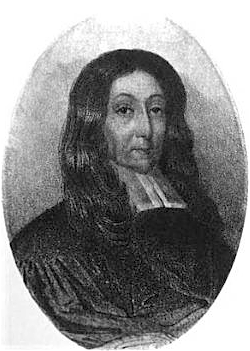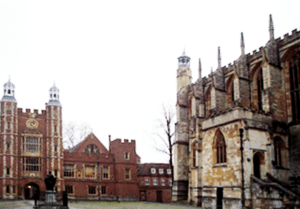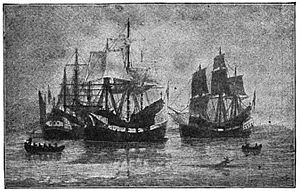John Wilson (Puritan minister) facts for kids
Quick facts for kids
John Wilson
|
|
|---|---|
 |
|
| Born | c. 1588 Windsor, Berkshire, England
|
| Died | 7 August 1667 |
| Resting place | King's Chapel Burying Ground |
| Education | B.A. 1609/10: King's College, Cambridge M.A. 1613: Emmanuel College, Cambridge |
| Occupation | Clergyman |
| Spouse(s) | Elizabeth Mansfield |
| Children | Edmund, John, Elizabeth, Mary |
| Parent(s) | Reverend William Wilson and Isabel Woodhull |
| Signature | |
John Wilson (born around 1588 – died 1667) was an important Puritan minister in Boston, part of the Massachusetts Bay Colony. He served as the minister of the First Church of Boston from its start in 1630 until his death in 1667. He is known for his disagreements with Anne Hutchinson during a time of religious debate (the Antinomian Controversy) and for being present at the execution of Mary Dyer in 1660.
John Wilson was born in a well-known English family. His father was a chaplain to the Archbishop of Canterbury, a very high position in the Anglican Church. Young John went to Eton College for four years. Then he studied at King's College, Cambridge, earning his first degree in 1610. He later studied law briefly and then got his master's degree from Emmanuel College, Cambridge in 1613. After becoming a minister, he worked for some important families. He then became a pastor in his hometown of Sudbury. Over the next ten years, he was sometimes removed from his job and then brought back. This happened because his strong Puritan beliefs often went against the rules of the main church.
Like many other Puritan ministers, Wilson decided to move to New England. He sailed with his friend John Winthrop and the Winthrop Fleet in 1630. He became the first minister for the settlers who first lived in Charlestown. They soon moved across the Charles River to Boston. Wilson was a great support to these early settlers during their difficult first years. He traveled back to England twice. The first time was to convince his wife to join him, as she had not wanted to come at first. The second trip was for business.
When he returned to the Massachusetts Bay Colony in 1635, Anne Hutchinson heard him preach for the first time. She noticed a big difference between his ideas and those of her mentor, John Cotton, who was the other Boston minister. Hutchinson was very smart and spoke her mind. She had been hosting large groups of followers in her home. She began to criticize Wilson, and this disagreement grew into the Antinomian Controversy. Eventually, Hutchinson was put on trial and told to leave the colony. Her brother-in-law, Reverend John Wheelwright, was also banished.
After this controversy, Wilson and Cotton worked together to help the Boston church heal. But after Cotton died, more problems came to Boston. People called Quakers began to arrive in the colony, sharing their beliefs. Wilson strongly disagreed with their ideas. He supported actions taken against them and was present at the execution of Mary Dyer in 1660. She had been a member of his church. John Wilson died in 1667. He was the longest-living of the early ministers in the Boston area. People who knew him were sad when he passed away. However, he is also remembered for his part in the harsh treatment of those who did not follow Puritan beliefs.
Contents
Early Life and Education
John Wilson was born in Windsor, Berkshire, England, around 1588. His father, Reverend William Wilson, was a chaplain to the Archbishop of Canterbury, Edmund Grindal. This meant his father held an important role in the church. John's mother, Isabel Woodhull, was the niece of Archbishop Grindal.

Wilson first went to school at Eton College for four years. He was once chosen to give a speech in Latin when a French ambassador visited. The ambassador gave him a special gold coin. On August 23, 1605, when he was 14, Wilson started at King's College, Cambridge. At first, he didn't like the Puritans. But he changed his mind after reading a book by Richard Rogers. He then traveled to Dedham to hear Rogers preach. Wilson and other students who shared his views often met to talk about religious ideas. He also regularly visited prisons to help the people there.
He earned his first degree from King's College in 1610. Then he studied law in London for a year. After that, he went to Emmanuel College, Cambridge, which was known for supporting Puritan ideas. He received his master's degree in 1613. While at Emmanuel, he likely became friends with future New England ministers like John Cotton and Thomas Hooker. He probably became a minister in the Anglican Church soon after.
In 1615, Wilson visited his father, who was dying. His father told him, "I have rejoiced to see the grace and fear of God in thy heart... Go by the rule of God's holy word, and the Lord bless thee." This advice encouraged Wilson to follow his strong beliefs.
Wilson worked for three years as a chaplain for several respected families. One of these was the family of the Countess of Leicester. He later dedicated his only book, Some Helps to Faith..., to her. This book was published in 1630. Eventually, he became the minister in Sudbury, his family's original hometown. While there, he met John Winthrop. Wilson was suspended and brought back as minister several times. This happened because his Puritan views did not always match the rules of the main Anglican Church. Like many Puritans, he started thinking about moving to New England.
Moving to Massachusetts

John Wilson was an early member of the Massachusetts Bay Company. He traveled to New England with John Winthrop and the Winthrop Fleet in 1630. As soon as they arrived, he, Governor Winthrop, and others made a promise to work together. Life was very hard in the new wilderness. A historian named Nathaniel Morton said that Wilson "bare a great share of the difficulties of these new beginnings with great cheerfulness."
Wilson was chosen as the pastor of their first church in Charlestown. He was officially installed on August 27, 1630. The government decided that a house should be built for him. They also ordered that Wilson's salary would be 20 pounds a year until his wife arrived. After the Charlestown church was set up, most of its members moved across the Charles River to Boston. Services were held in both places for a while, and then only in Boston.
Before leaving England, Wilson married Elizabeth Mansfield. They had at least two children born in England. However, his wife did not want to come to New England with him at first. Wilson then made a trip back to England from 1631 to 1632. Although some historians thought she didn't come until 1635, records show they had a child baptized in Boston in 1633. This means she must have come with him on that earlier trip.
On July 2, 1632, Wilson became a freeman of the colony. This meant he had full rights as a citizen. Later that month, the first meeting house was built in Boston. The church members gave money to build this and Wilson's home. On October 25, 1632, Wilson, Governor Winthrop, and a few others visited Plymouth. They were welcomed warmly. They held a worship service and discussed religious questions. The Boston men returned a few days later.
On November 23, Wilson was officially installed as the minister of the First Church of Boston. In 1633, another minister, John Cotton, arrived and joined the Boston church. In November 1633, Wilson visited Agawam (later Ipswich), where settlers did not yet have a minister. He also visited the native people, helping the sick and teaching those who could understand him. He became the first Protestant missionary to Native Americans in North America. This work was later continued by Reverend John Eliot. Wilson sometimes led groups of Christians to church talks in nearby towns, sharing his "heavenly discourse" during the trip.
In late 1634, Wilson made his last trip to England. He left the Boston church in the care of John Cotton. While returning to England, he had a dangerous experience during a winter storm off the coast of Ireland. Other ships sank, but his landed safely. During his journey across Ireland and England, Wilson helped many people and told them about New England. John Winthrop wrote in his journal that Wilson "gave much satisfaction to the Christians there about New England." Wilson left England for the last time on August 10, 1635. He arrived back in New England on October 3. Soon after his return, the Antinomian Controversy began. This was a fierce religious debate that lasted for two years and threatened to divide his church.
Later Years and Challenges
After Anne Hutchinson left the colony, Wilson worked with John Cotton to bring the Boston church back together. After Cotton died in 1652, John Norton took his place as minister. Norton held this position until his death in 1663.
Wilson was one of the first people to support converting Native Americans to Christianity. He acted on this belief by taking in the orphaned son of Wonohaquaham, a local Native American leader. He educated the boy in his home. In 1647, he visited the "praying Indians" of Nonantum. He noticed they had built a church that looked like an English house. In the 1650s and 1660s, church membership was decreasing. To help with this, Wilson supported a rule called the Half-Way Covenant. This rule allowed people to join the church even if they hadn't had a strong religious experience.
In 1656, Wilson and John Norton were the ministers of the Boston church when a widow named Ann Hibbins was accused of witchcraft. She was found guilty by the General Court and executed in Boston. Her husband had died in 1654. She was tried after her neighbors complained about her behavior. Details about this event are not very clear. However, a letter from 1684 mentions that Norton said Hibbins was executed only because she was smarter than her neighbors. This suggested she was innocent. While Wilson's exact feelings are not known, some believe he felt the same way as Norton.
The Execution of Mary Dyer

In the 1650s, Quaker missionaries started coming into the Massachusetts Bay Colony. They mostly came from Rhode Island. This worried the colony's leaders and ministers, including Wilson. Wilson strongly believed in Puritan ideas and disliked the Quakers' different beliefs.
On October 27, 1659, three Quakers—Marmaduke Stevenson, William Robinson, and Mary Dyer—were led to the gallows in Boston. They had been jailed for spreading their Quaker beliefs, which Massachusetts had made illegal. Wilson, who was nearly 70, was there as the supervising minister. As the two Quaker men approached the gallows, Wilson spoke to Robinson. Robinson then started speaking loudly. Wilson angrily told him to be quiet, saying he was "going to die with a lie in your mouth." The two Quaker men were then hanged.
It was then Dyer's turn. As the rope was put around her neck, a young man ran up, waving a document. Governor Endecott had stopped her execution. After the two executions, Wilson was said to have written a song about the event. Young men in Boston sang this song.
Mary Dyer did not want the public's feelings about the executions to fade. She felt she needed to go through with her death to make a point. After the winter, she returned to the colony in May 1660. She was immediately arrested. On May 31, she was brought before Endecott. He questioned her briefly and then ordered her execution for the next day. On June 1, Dyer was led to the gallows again. As she stood there for the last time, Wilson called out to her. He had welcomed her into the Boston church 24 years earlier and baptized her son. He said, "Mary Dyer, O repent, O repent, and be not so deluded and carried away by deceit of the devil." Her reply was, "Nay, man, I am not now to repent." With these final words, the ladder was kicked away, and she died.
Death and Lasting Impact
John Wilson was sick for a long time before he died. In his will, dated May 31, 1667, Wilson remembered many people. These included several local ministers, like Richard Mather and Thomas Shepard Jr. He died on August 7, 1667. His son-in-law, Samuel Danforth, wrote about his passing. He said Wilson was "a man eminent in faith, love, humility, self-denial, prayer, soundness of mind, zeal for God, liberality to all men." He was "loved and mourned by all." His funeral sermon was given by a local minister, Increase Mather.
Wilson was known for making anagrams, which are words or phrases made by rearranging the letters of another word or phrase. He made them from the names of his friends. One story, whether true or not, shows Wilson's character: Someone told him his house had burned down while he was away. Wilson supposedly replied, "Blessed be God! He has burnt this house, because he intends to give me a better." This shows his strong faith.
In 1809, historian John Eliot described Wilson as friendly in speech but sometimes acting superior. An early mentor of Wilson's, Dr. William Ames, said that if he could choose the best life on Earth, it would be to be a teacher in a church where Mr. Wilson was the pastor. Plymouth historian Nathaniel Morton called him "eminent for love and zeal." Wilson was also known for being very modest. He refused to ever have his picture painted. He would say, "What! Such a poor vile creature as I am! Shall my picture be drawn? I say No; it never shall." It is believed that a drawing of Wilson in the Massachusetts Historical Society was made after his death. Cotton Mather, a famous Puritan, wrote that Wilson was a "good" and "great" man. He said Wilson's picture would show "great zeal, with great love," along with his strong beliefs.
Family Life
John Wilson's wife, Elizabeth, was the sister of Anne Mansfield. Anne was married to the wealthy Captain Robert Keayne of Boston. Captain Keayne left money to Elizabeth in his will in 1656. John and Elizabeth Wilson had four known children. Their oldest child, Edmund, went back to England, got married, and had children. Their next child, John Jr., went to Harvard College in 1642. He married Sarah Hooker, the daughter of Reverend Thomas Hooker.
The Wilsons also had two daughters. The older daughter, Elizabeth, married Reverend Ezekiel Rogers. She died while pregnant with their first child. The younger daughter, Mary, was born in Boston on September 12, 1633. She first married Reverend Samuel Danforth. After he died, she married Joseph Rock.
See also



